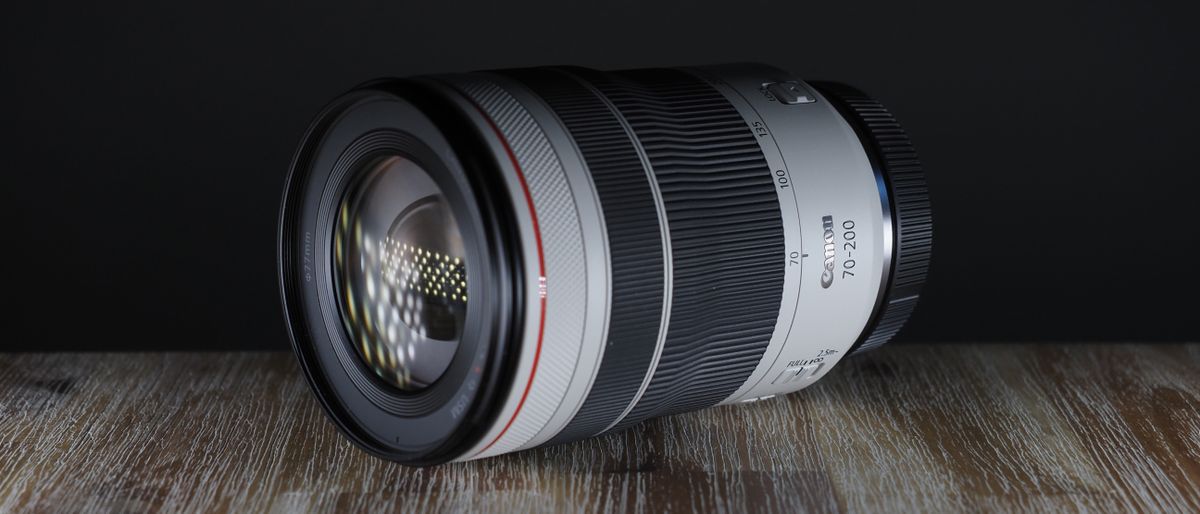Digital Camera World Verdict
The Canon RF 70-200mm f/4L IS USM is almost a miniature marvel – it's so small that it can fit into a sling bag while still mounted on a camera. Center sharpness at 200mm is as good as at 70mm, and with up to 7.5 stops of stabilization it delivers rock-solid performance for both stills and video. Unfortunately, the price of its compactness is incompatibility with teleconverters, and corner sharpness isn't what it might be – both of which come as a sting in the tail, when it costs as much as 50% more than the EF equivalent,
Pros
- +
Shortest (FF) 70-200mm ever
- +
Great center sharpness
- +
Quick, quiet autofocus
Cons
- -
Teleconverters not supported
- -
Pricey for an f/4 lens
- -
No tripod foot
Why you can trust Digital Camera World
The Canon RF 70-200mm f/4L IS USM arrived with far more fanfare than traditional f/4 zoom lenses. For starters, it's the shortest and lightest 70-200mm f/4 in the world – it's only slightly larger than a soda can when collapsed!
Yes, it's even shorter (by 18%) and lighter (35%) than the already tiny Canon RF 70-200mm f/2.8L IS USM – small enough to slide into a small sling bag. And it delivers an astonishing maximum of 7.5 stops of stabilization, making it truly formidable for handheld shooting.
On paper, then, it's one of the best 70-200mm lenses around – but there's the small issue of price, as this RF lens is significantly more expensive (as much as 50% more) than the existing Canon EF 70-200mm f/4L IS USM II, which can of course be mounted to EOS R cameras.
So, does the overall performance justify the price? Let's find out…
Canon RF 70-200mm f/4L IS USM video review
Watch video: Canon RF 70-200mm f/4L IS USM review
Canon RF 70-200mm f/4L IS USM – Specifications
Mount: Canon RF
Full frame: Yes
Autofocus: Dual Nano USM
Image stabilization: 5 stops (7.5 with Canon EOS R5 / Canon EOS R6)
Lens construction: 16 elements in 11 groups
Angle of view: 29° - 10° (horiz), 19° 30' - 7° (vert), 34° - 12° (diag)
Diaphragm blades: 9
Minimum focusing distance: 0.6m
Maximum magnification ratio: 0.28x
Filter size: 77mm
Dimensions: 83.5 x 119mm (collapsed)
Weight: 695g





Canon RF 70-200mm f/4L IS USM – Key features
Without doubt, the headline feature of the RF 70-200mm f/4L is its size – or, rather, the lack of it. At just 83.5 x 119mm (collapsed) and 695g, it's 27mm shorter and 375g lighter than the 89.9 x 146mm (collapsed) and 1,070g heft of the RF 70-200mm f/2.8L
Compared to its direct DSLR equivalent, it's even more impressive. The EF 70-200mm f/4L is 780g and 176mm – and that's before you add the extra size of the Canon mount adapter, which you'll need to put an EF lens on your EOS R camera.
When attached to a non-stabilized body – the Canon EOS R, Canon EOS RP or Canon EOS Ra – this lens delivers a solid 5 stops of stabilization. However, mount it to the IBIS-enabled R5 and R6 and the combination IS delivers an enormous 7.5 stops of stabilization – that's half a stop less than the RF 70-200mm f/2.8L, but is still incredibly impressive.
The floating dual Nano USM autofocusing system also produces speedy, snappy AF for stills along with smooth and near-silent focus for filming video. In short, there's a whole lot to like about this lens.
Canon RF 70-200mm f/4L IS USM – Build and handling
Dimensions can be a bit nebulous when you just read them out. So to put them into context, not only can you stand the RF 70-200mm f/4L upright in your normal camera bag – you can also mount it to your camera and put the whole thing into a small sling bag. And that's just crazy.
As you'd expect from an L lens, the optic is weather sealed and built to last with vibration and shock-resistant construction. Of course, like the trinity version before it, this lens features a telescoping zoom mechanism that extends the lens barrel as you zoom in.
This features a perforated seal on the moving inner barrel, to enable air movement while keeping dust and moisture out. While we previously had reservations about whether water and particulates would penetrate the seals (especially if zooming in and out in wet or dusty conditions), we've yet to hear any such complaints about the f/2.8 version so we've no reason to believe it will be an issue here.
An issue that does carries over from the trinity lens, however, is the incompatibility with the Canon RF Extender RF 1.4x and Canon RF Extender RF 2.0x teleconverters. This is a physical limitation, due to the collapsing nature of the lens, and is a big drawback for a 70-200mm lens.

Another drawback is the lack of a tripod foot. While this optic isn't as heavy as its f/2.8 counterpart, we'd still be much happier taking the strain off the mount by being able to attach a tripod to a lens collar – and of course, some people find that having a foot helps with handling a telephoto lens.
Like all Canon RF lenses, this one features a customizable control ring on the nose. This can be mapped to adjust exposure values such as ISO, white balance, shutter speed and aperture – the latter being of particular interest to videographers, though note that the ring is not clickless by default.
Elsewhere on the lens you will find sliders that control the locking mechanism (to stop the mechanism from telescoping in your bag), toggle between automatic and manual focus, and switch between the full focus range or limit it to 2.5m-∞.
Finally, again like its big brother, the RF 70-200mm f/4L features three image stabilization options: Mode 1 is for general shooting, Mode 2 is for panning shots, and Mode 3 only engages the IS system when the shutter is released (giving a more 'honest' view of subject movement, and only turning on the stabilization when a shot is taken, which conserves battery as the IS isn't constantly running).

Canon RF 70-200mm f/4L IS USM – Performance
The RF 70-200mm f/4L is a bit of a tale of two halves. On the one hand, center sharpness is uniformly excellent – even shooting at the full 200mm extension, which is where telephotos often fall short.
While full zoom is sharpest at f/5.6, the lens otherwise sees peak performance wide open at f/4 – which is incredibly helpful, if you're shooting in low light conditions, handheld or want to achieve the greatest subject separation.
Corner sharpness, however, falls somewhat short of expectations at the wide end and midrange. Depending on how you compose your shots this may be less of an issue, but the inconsistency is disappointing for an L lens.
In terms of autofocus, the f/4L seems to perform as snappily as the trinity version thanks to the same dual floating Nano USM design. Even when photographing darting subjects like squirrels and birds, the AF didn't miss a beat – and on human subjects, the Eye AF is as ungodly good as it is with any other optic.
Another advantage of the floating focus system is this lens' ability to focus at just 0.6m across the entire zoom range – an improvement over the 1m minimum focus distance of the EF 70-200mm f/4, and it even beats the 0.7m of the RF 70-200mm f/2.8 as well.
While the focusing system doesn't entirely suppress focus breathing, the phenomenon is controlled pretty well and makes this lens well suited to videography, particularly with the near-silent AF performance.

Canon RF 70-200mm f/4L IS USM – Lab data
We run a range of lab tests under controlled conditions, using the Imatest Master testing suite. Photos of test charts are taken across the range of apertures and zooms (where available), then analyzed for sharpness, distortion and chromatic aberrations.
We use Imatest SFR (spatial frequency response) charts and analysis software to plot lens resolution at the centre of the image frame, corners and mid-point distances, across the range of aperture settings and, with zoom lenses, at four different focal lengths. The tests also measure distortion and color fringing (chromatic aberration).
Sharpness:
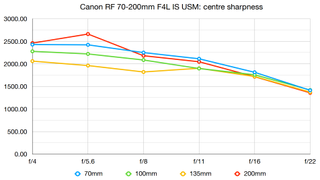
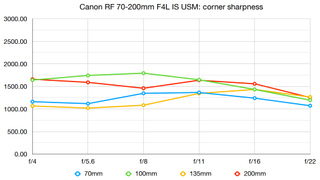
As we'd expect for a Canon RF-mount lens, center sharpness is excellent at all focal lengths and commonly used apertures. Particularly impressive is sharpness at 200mm; most telephoto zooms tend to tail off in terms of sharpness at full zoom, but the RF 70-200mm f/4 bucks that trend.
Corner sharpness is more of a mixed bag. Sharpness is disappointingly soft in the corners at 70mm, but quickly becomes sharp when you zoom in to 100mm. However, corner sharpness slips again at 135mm, before becoming respectable again at 200mm. This blip at 135mm is unusual, and there's a chance it could be unique to our test sample. At least corner sharpness is consistent throughout the lens' aperture range.
Fringing:
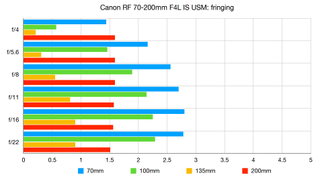
Fringing is noticeable at all focal lengths apart from 135mm, though these results are obtained with in-camera aberration correction disabled. You can expect significantly reduced fringing if you enable in-camera lens corrections.
Distortion:
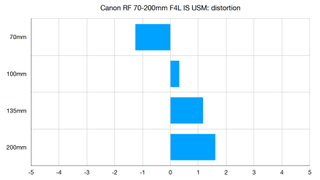
Negative scores indicate barrel distortion, positive scores indicate pincushion. A score of zero signifies no distortion.
With in-camera distortion correction deactivated, there's mild barrel distortion at 70mm, transitioning to minimal pincushion at 100mm. This then increases in severity at 135mm and 200mm. However, at no point in the focal range is distortion distracting.
Canon RF 70-200mm f/4L IS USM – Verdict
The Canon RF 70-200mm f/4L IS USM lens is an impressive all-rounder – though this jack of all trades does come with a couple of compromises.
It's small enough to fit into almost any camera bag you have, and is light enough to be a truly take-anywhere lens – which is an astonishing achievement for a 70-200mm, and finally delivers on the promise of mirrorless cameras actually being smaller thanks to similarly svelte lenses.
It delivers incredible image stabilization, too, along with autofocus that squeezes every ounce of performance out of your camera whether its the original EOS R or the cutting-edge R5. And center sharpness is fantastic, even at 200mm, even though corner sharpness can be disappointing.
The caveats, though, are familiar to the f/2.8 version: this lens is not compatible with teleconverters, which many photographers will find unfathomable for a 70-200mm, and it's very pricey compared to the (admittedly far less sophisticated) EF version.
At the end of the day, this is a great technological achievement and a lens you'll be glad to own and use. However, the cost of entry and inability to make the lens as versatile as it can be remain reasons to bristle.
Read more:
Best Canon RF lenses
Best Canon lenses
Canon RF 70-200mm f/2.8L IS USM review
Canon EF 70-200mm f/4L IS USM II review

James has 22 years experience as a journalist, serving as editor of Digital Camera World for 6 of them. He started working in the photography industry in 2014, product testing and shooting ad campaigns for Olympus, as well as clients like Aston Martin Racing, Elinchrom and L'Oréal. An Olympus / OM System, Canon and Hasselblad shooter, he has a wealth of knowledge on cameras of all makes – and he loves instant cameras, too.
